Profiled sheet fencing is quite common. The material is opaque, strong, durable, easy to install. However, it does not apply to self-supporting. In order for such a fence to serve for a long time, you need to create a solid frame of pillars and crossbars.
- What pipe to make a fence
- Wooden posts for corrugated board
- Fence made of corrugated board with pillars of asbestos-cement pipes
- Pillars for corrugated metal pipes
- Fence made of profiled sheet with brick pillars
- Fence pipe thickness
- Calculation of the number of pillars and the distance between them
- Depth of installation of pillars
- Features of installing pipes for fencing
What pipe to make a fence
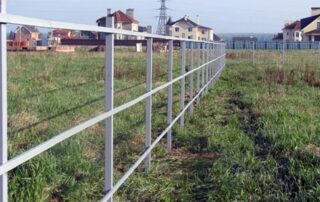
A fence made of corrugated board, with all its advantages, has one unpleasant feature. The sheet does not allow air to pass through, therefore the fence is exposed to very serious lateral loads. With the wrong choice of the frame or its device, the canvas is deformed, bent under the pressure of the wind, the structure looses and can completely become unusable.
You need to choose the right pillars for the corrugated board and calculate the frame.
Wooden posts for corrugated board
Wood is the most common material. The choice on the market is huge, the material is easy to process. Serves quite a long time if handled correctly. At the same time, wooden structures weigh much less than metal or brick ones.
For support posts, a rounded log is taken, preferably with a partially removed bark - such a tree lasts longer. The diameter of the log is from 12 to 15 cm. Preference is given to conifers - pine, spruce, larch. Such wood contains a lot of resins, and these substances provide resistance to rain and moisture.
The advantages of wooden poles:
- ease of processing and installation;
- the ability to mount in any way and any materials;
- high maintainability;
- sufficient resistance to stress.
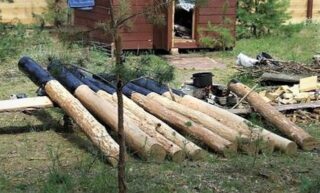
The disadvantages are as follows:
- the tree is prone to rot and mold, so the material must be protected;
- the combination of wood and profiled sheet is unattractive in appearance.
Installation of such a fence is very simple. The logs are cut to length, and the part that will be underground is treated with bituminous mastic, then the supports are dug into the pits or concreted. The lintels are usually also fastened with wooden ones, and then the profiled sheet is screwed on with self-tapping screws. They put the sheets outside so that the wooden parts are not visible.
If a shredded log is used, and even more so a bar, the pillars are pre-treated with an antiseptic, at least linseed oil. It is recommended to paint the fence to protect it from moisture.
Fence made of corrugated board with pillars of asbestos-cement pipes
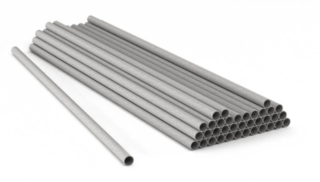
For the fence, asbestos-cement pipes are often used. They serve as a kind of formwork. The pipe is deepened into the ground, and then concrete is poured. When the material is set, a strong, reliable support is obtained. You can put not only a light professional sheet on it.
However, the structure is heavy and therefore requires a foundation. The racks are concreted with their own hands in pits with a depth of 80 to 150 cm.To make the support more reliable, holes are pre-drilled in the pipe and reinforcement is inserted into it. When concreting is carried out, the reinforcement reliably ties the post to the foundation.
Also, before installation, it is required to make holes for fastening the crossbars. As the latter, metal pipes with a cross section of 40 * 40 mm are used, but if the length of the run is more than 3 m, the profile must be taken more massive.
The advantages of a fence with such a frame are many:
- resistance to high loads - the length of the run is allowed more than 3 meters, despite the high windage;
- strength - the pillar with the foundation forms one whole, so that overturning or displacement of the supports is impossible;
- high durability;
- asbestos pipes do not require any maintenance.
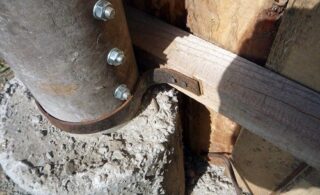
There are also disadvantages:
- installation is quite complex and requires preparation;
- the appearance is unpresentable;
- if the pipe is damaged, repair is difficult.
It is very difficult to dismantle such a fence. However, if necessary, you can remove the profiled sheet and replace it with another filler.
Pillars for corrugated metal pipes
For a fence made of profiled sheet, metal posts are best suited. Moreover, a variety of types of metal products are used as support: round and shaped pipes, equal and non-equal angles, channels, I-beams.
The most convenient pipes are square or rectangular, since it is much easier to attach the material to a flat surface.
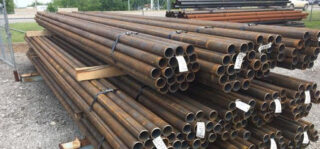
Black steel pipes are used for fencing. Such an alloy is prone to corrosion and needs protection. Therefore, the pipes are pre-treated with a primer and painted or coated with special compounds that provide protection against moisture. The galvanized profile is used much less often, since it is expensive.
It is important to take into account the design features. A single channel or corner can be supported only if the width of the latter reaches 18 cm, and the length of the second shelf is 56–75 mm. If the elements are smaller in size, "boxes" are welded from them, which are installed like ordinary pillars.
The advantages of this solution:
- high strength - the length of the run can be more than 3 m;
- the structure weighs less than a brick or concrete pillar, but it will still have to be concreted;
- the fence can always be repaired;
- the fence looks aesthetically pleasing.
Disadvantages:
- metal supports must be periodically primed and painted;
- installation is not so simple, since the structure weighs a lot;
- the installation requires the ability to work with a welding machine.
Even old pipes are often used for fencing. This is allowed if the thickness of the products meets the standards, and the defects are small. The profile is preliminarily cleaned from rust and primed.
Fence made of profiled sheet with brick pillars

A brick support is the most durable, reliable, but also the most time consuming option. Such a fence cannot be overturned or damaged by any wind. And after dismantling the corrugated board, you can install any filling, even the heaviest.
For pillars, they take silicate, facing, clay bricks - corpulent or hollow. Any material provides sufficient reliability.
The technology is not simple. The brick pillar is heavy, so a foundation is required for it. The stiffening element of the support is a metal pipe. The pipe is installed in a pit, covered with rubble and concreted. Steel plates with a length exceeding the width of the future pillar are welded onto it: crossbars will be attached to them. The maximum pipe size is half a brick, that is, usually it is 12 * 12 cm. More often they use the option with a section of 6 * 6 cm, and pipes with a large section are placed under the gate. The length is equal to the sum of the deepening and the height of the future pillar.
The steel core is lined with bricks. Lay in the usual way. The opening between the pipe and the stone is filled with concrete or cement.
Brick pillars have the following advantages:
- the highest strength and reliability of the fence;
- the possibility of replacing the filling, since the material is not attached to the post, but to the mounting plates;
- brick pillars do not need care;
- very attractive appearance;
- high durability.
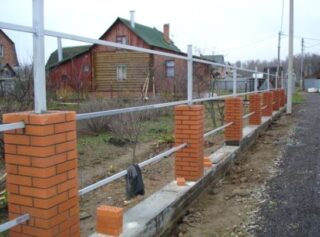
Considerable cons:
- installation is complicated and time-consuming;
- the structure weighs a lot and is placed on the foundation;
- high cost of fencing.
Brick pillars are usually erected for more interesting, attractive content. The professional sheet often serves as a temporary fence.
Fence pipe thickness
The dimensions of the fencing pipe depend on several factors:
- fence height;
- span length;
- wind load.
With a standard run length of 2.5–3 m, round and shaped pipes with a wall thickness of at least 3 mm are taken. If the height of the fence is less than 2 m, it is allowed to use pipes with a wall 2 mm thick. If the fence is higher, then only with a wall thickness of 3 mm.
The pipe diameter is also selected based on the above parameters. For a fence with a span of less than 2.5 m, a pipe with a diameter of 89 cm is suitable.If the length of the run or the height of the fence is greater, a pipe with a diameter of at least 108 mm is required.
The section of the profile pipe is determined in the same way. For standard sizes, take an option with a cross section of 60 * 60 mm. If the girder is longer or the fence is being built in an area with a high wind load, products with a section of 80 * 40 mm are needed.
Calculation of the number of pillars and the distance between them
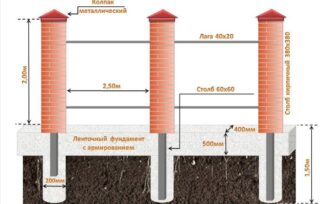
The number of supports for the fence is calculated taking into account not so much the wind load as the width of the corrugated sheet. On average, its total width is 120 cm, and the working width is 115 cm.However, there are brands for which these values are 115 and 110 cm.
When installing on a fence, the overlap when laying corrugated board is minimal - 5 cm.If the run is 2 sheets, its length will be 2.35 m, if 3 - then 3.5 m.This value is very large in terms of windage, therefore, for example, with using brick pillars, the length of the run is 2.35 m.
If the posts are made of metal pipes, the length of the run is more often 3 m. Installation along the axes of the posts is optimal, but only if the fence lags are overlapped on the posts. In addition, it is important that a pipe with a cross section of 40 * 20 mm and a wall thickness of at least 1.5 mm is used for the crossbars. If the profile is smaller in cross-section, it is better to reduce the distance between the posts.
If the lags on the iron pillars are butt welded, the calculations are performed as for brick pillars.
The height of the fence must also be taken into account. The above calculations are relevant for a fence height of 2 m, that is, horizontal stacking of sheets. If this value is higher and the sheets are mounted vertically, the distance between the posts will have to be reduced.
Depth of installation of pillars
The depth of the pillars for the profiled sheet fence depends mainly on the nature of the soil. The corrugated board is light, such a fence does not exert a heavy load on the posts. Sailability is much more important, but it more affects the distance between the posts and the nature of the supports.
- When installed in dense clay soil by hammering or backing, the immersion depth rarely exceeds 100 cm.A deepening of 80 cm is considered optimal with a run length of 2.5 m and a height of 2 m.
- The filler soil has a much lower density. When calculating, you need to take into account the subsidence of the soil. On average, when installing a light fence, the support is hammered into 1/3 of its total height. For heavy structures, support on a horizontal line will be required, that is, the installation of a reinforced concrete foundation.
- Heavily or too wet soils suggest only 2 installation options. The depth of the posts for the fence made of light corrugated board depends on the depth of the groundwater. On average, the value is 50-60 cm. However, due to the mobility of the soil, it is impossible to simply muddle up the pillar. Dig a hole for support. They put a pipe in it and concrete it.
Screw piles can be used: they are screwed into the ground below the freezing horizon.
Features of installing pipes for fencing
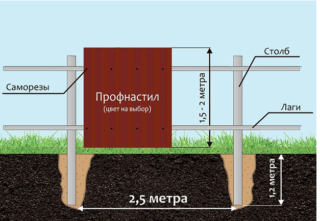
The construction of a fence from a metal profile and a profiled sheet has a number of other features.
- Whichever installation method is used, part of the pipe will end up underground. Before immersion, it is necessary to treat this fragment of the product with bitumen mastic.
- The profiled sheet can be attached from the inside or outside.In the first case, the canvas is fastened along the very edges, in the second - 20-30 cm remains between the log and the edge of the sheet.
- When installing sheets from the inside, the height of the posts and the fence is the same. When assembled from the outside, the support is usually lower than the guardrail.
- The upper edge of the pipes must either be welded or closed with a plug so that rain and snow do not fall into the column.
- After welding, all visible parts of the frame are primed and painted.
Fence made of profiled sheet - the fence is light enough. However, depending on the method of fastening the sheet, the weather conditions of the area, the nature of the soil, the frame for it is constructed differently.








